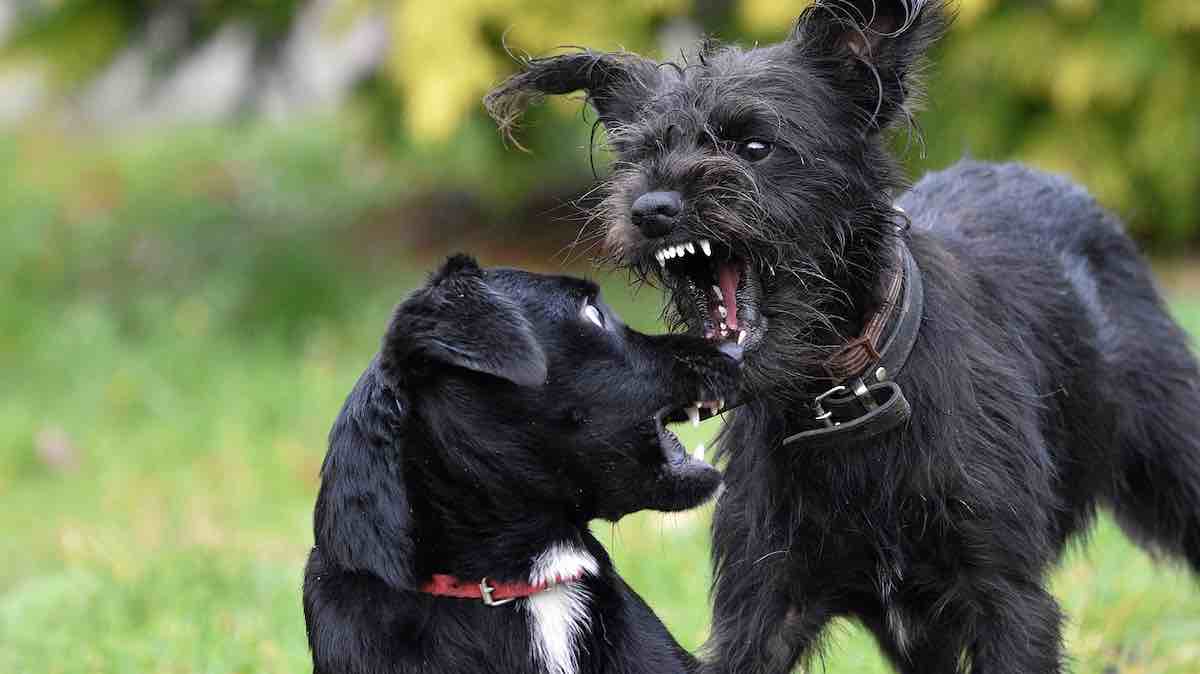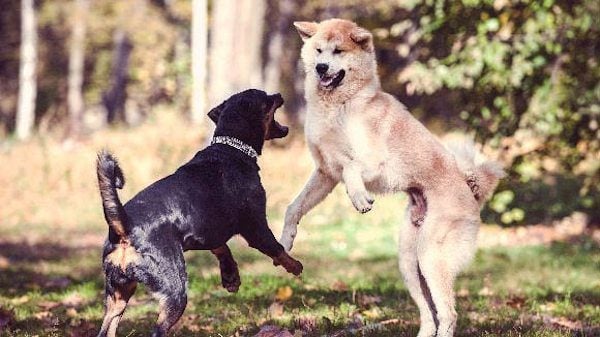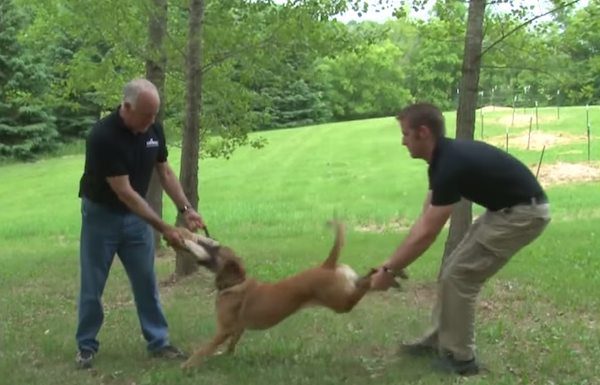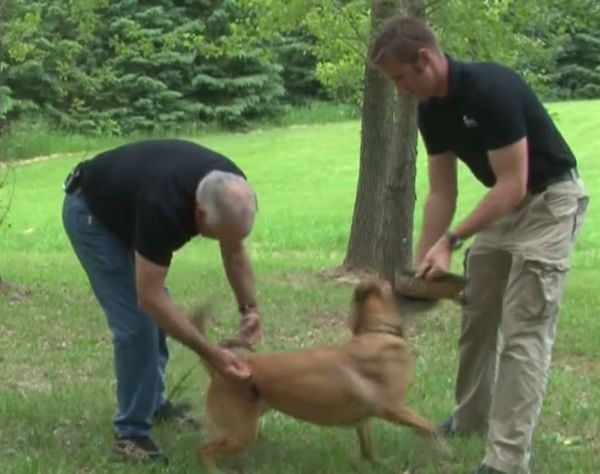How to Safely Break Up a Dog Fight
If you’ve ever taken your dog to a dog park or to an off-leash walk you’ve probably seen two dogs get into a fight at some point or other. It can be a terrifying sight. Many pet parents panic and don’t know what to do. Oftentimes, people will do exactly what they shouldn’t do and get bitten as a result. That’s because many people have never learned what methods are unsafe and what ones are recommended when dealing with a dog fight.
Every dog fight is unpredictable and there is always a risk of harm no matter what technique is used to try and break one up. Always consider your personal safety before acting and educate yourself on some of the recommended ways of breaking up a dog fight in order to minimize the risk of getting hurt. And remember, you can always call the authorities for help if you judge that it is too dangerous to intervene.

Real dog fight or play fight?
The first thing to determine is whether or not the two dogs are actually fighting or simply play fighting. Sometimes when dogs play it can appear pretty violent, especially to people not familiar with dog behavior. There may be growling, snapping and tussling.
The easiest way to tell if you are looking at dogs rough playing is to look at the dogs’ body language. Their bodies will appear loose, bouncy and elastic (not rigid or stiff) and you will usually notice their tails wagging and happy grins on their faces.


If it appears that one dog is dominating the other (ergo one dog is not into the rough play), it’s probably time to separate them. If the energetic dog isn’t yours, politely ask the dog’s owner to separate them, or call your dog over to you.
If it’s a real fight…
Breaking up a dogfight can be extremely dangerous and unpredictable. In most cases, a fight lasts just seconds and can be broken up by simply shouting at the dogs. If that doesn’t work map out a plan that will work best for the situation you (and the dogs) are in.
DON’T PANIC.
The most important thing to remember is don’t panic. By panicking you increase the risk of personal injury and prolonging the fight. Dogs sense fear and panic and it could make the whole situation worse than it is.
There is a difference between a dog fight and a dog attack. If one dog is clearly the aggressor and attacking a submissive dog, then place your focus on removing the aggressive dog from the other dog.
Many people go with their first instinct and grab for their dog’s collar. WRONG! This increases the odds of being bitten dramatically. Dogs in the middle of a fight are in adrenaline mode and will not recognize their owners. They will lash out at anyone and anything.
STARTLE THE DOGS OR USE A BARRIER.
Interrupt a fight through startling techniques or a barrier is often effective enough to break up a fight. It also is effective in keeping you out of reach of the dog’s teeth.
Startling techniques may include:
- Bang on a pan or garbage can lid or something that makes a loud, distinctive noise. If you have a small air horn this is very effective. A sudden, loud shout, whistle or clap. Do not scream, this will be interpreted as panic and fear and won’t be effective. Make sure the noise is loud enough to surprise them. A few very loud claps along with a firm and confident BACK OFF.
- Splash or spray them with water, using a water bucket or hose (if handy).
- Put an object between the fighting dogs (such as a folded lawn chair, piece of plywood). Don’t throw the objects at the dogs but insert them between them.
- Throw a blanket over the dogs
- Use a citronella spray (e.g. Sprayshield, BOOTAT Dog Corrector Spray on the dogs’ noses.
If this doesn’t work you may attempt to physically separate the dogs. Physically intervening is always much more dangerous an option and increases your risk of being bitten.
USE THE WHEELBARROW METHOD TO PHYSICALLY SEPARATE THEM.
As mentioned, do not go for the collar area or approach the dogs from the front. You want to stay away from their heads (and mouths) as much as you can.
Instead, approach the dogs from the rear and use the wheelbarrow method. It is important that both pet parents do this together at the same time so that the two dogs are separated at the same time.
- Grab your dog by his hind legs at the very top, near the thighs (just under the hips), and lift his legs into the air like he’s a wheelbarrow.
- By holding a dog this way you are in complete control of your dog, while staying far away from their teeth.
- Hold on to his hind legs and start quickly back up in a zig zag motion. (this will force the dogs to let go of each other).
- Once both dogs are a few feet away from each other, spin your dog around so he no longer can see the other dog.


IF YOU ARE ALONE…
Breaking up a dog fight by yourself is far more challenging and dangerous. If you are in doubt of your safety in any way you should stand back as the risks of getting hurt are much higher if you are alone.
If you choose to approach the two dogs, here are some guidelines:
- Call for help.
- Get a leash (two is better) if you don’t have one with you.
- Approach one of the dogs (if you can determine the aggressor, go for this dog first). Again, approach the dog from the rear. Loop the leash around the dog’s hind quarters (just in front of his back legs). Immediately back away while pulling the dog by the leash.
- Fasten and secure this dog to a pole, fence post or tree.
- Then move to the second dog and grab him using the wheelbarrow method (above).
- Drag the dog further away than you would if you had someone else to help.
- Find a way to secure the dog (perhaps using a second leash), and out of sight of the other dog, if possible.


Ed Frawley goes through several points on breaking up a dog fight in his useful YouTube video you can view here. Note: The video shows the dog being grabbed by his feet. Some trainers advise that a dog should grabbed at the upper leg because you can injure the dog if you grab them by the feet.
Please note that no matter what technique you may decide to use, attempting to intervene in a dog fight is unpredictable, dangerous and there is no guarantee that any these techniques will be effective or successful. These tips are meant to be help you but there is no guarantee that these techniques will work or prevent injury or harm to you, your dog or other dogs and people.
Remember, it’s always better to monitor your dog while he/she plays so that you can prevent a dog fight from happening in the first place. Teaching your dog the recall command and back-off command will help de-escalate a situation and keep your dog safe.
One of our DogHeirs members shared some of their advice for keeping safe.
“I’d like to reiterate that there is no magic solution to a dog fight and it will alway be dangerous. Remember that dogs when they reach the red zone are in survival mode and are extremely fast. If you think that your reflexes can be faster than a dog’s, think again. A dog’s visual perception of motion is much better than ours. This is called the flicker fusion rate,” says Darrin Henry. F”or someone who has no experience with breaking up a dog fight they should be extremely cautious when using a technique like [the wheelbarrow method] and take some other factors into consideration. The size and weight of a dog should be considered as well. If the dog’s weight is in the 100 pound arena and your weight is 140 to 150 pound arena, picking up a dog in a fury by his hind quarters and swinging him around through the air to face the other way may be beyond your physical capability.”
“For those of you who are having problems with multiple dogs in the home, take the time to learn what the signs of stress are in your dogs. Loss of appetite, refusal of food, diarrhea, diverted eyes, tail between the legs and the ears back. Feed your dogs separately and don’t leave their toys out when you aren’t there to supervise,” suggests Henry. “If you have another dog over for a visit, pick up all toys and bones as well as the food dish. Be prepared with the proper equipment if a fight does occur. If you see things starting to get out of hand intervene before the fight starts. I think that knowledge and prevention is the key here.”
He adds, “Know your environment. I have been jumped by neighborhood dogs many times. I’ll be on a regular utility walk with the dogs and someone will come to their door to let their dog out and the dog will bolt down their driveway in defence of their property. Dogs have much better hearing in a lot of cases and will hear you walking by from inside their house unbeknownst to their pet parents and bark to go outside. One thing you can do to help avoid this scenario is to do a noise audit of you and your dog. Does your dog’s collar or tags make a metal on metal noise when you are walking? Tie them together with a rubber band or get rubber covers for them. Covering the collar ring with hockey tape on your dog’s collar can also stop a noisy giveaway. I’ve seen delivery people and Mail people make the same mistake by hanging large noisy key chains from their belts. Once, a long time ago, this scenario happened to me and a lab rottie mix came bolting down a driveway at me and my dogs. The woman at the door panicked and I was in a bit of a bad mood. I yelled at the dog in my meanest voice “get back in the house!” I startled the dog with a command that he was obviously familiar with so he turned around and went right back in the house. Using familiar commands can sometimes do all that needs to be done.”






